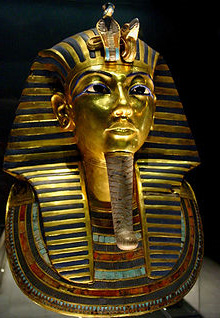The mystery of the Mummy
Not all science is equally ‘scientific’
Published: 26 April 2011(GMT+10)
(This is the pre-publication version which was subsequently revised to appear in Creation 35(2):12–14.)

Credit: Wikipedia.org
Scientists have argued a great deal about the cause of death of the famous Egyptian pharaoh, Tutankhamun.1 For many years, people believed that the boy-king had died from a haemorrhage, following a blow to the head. Some even speculated that he had been murdered.
However, following extensive CT scanning in 2005, a number of experts, including Frank Rhüli of the University of Zurich, concluded that there had been no blow to the head. Instead, it was suggested that the young pharaoh had suffered a break to the left thigh bone, possibly leading to fatal bleeding or infection. Some were more dogmatic, such as experts featured in the National Geographic documentary, King Tut’s Final Secrets. The evidence was unequivocal, they claimed; Tutankhamun clearly died from complications following a broken leg.
Another team of experts, featured in the Discovery Channel documentary, King Tut Unwrapped, came to a different conclusion. The young pharaoh was a deformed, sickly youth who died of malaria they said. The CT scans, they argued, showed that he had diseased bones, a club foot and a cleft palate. Moreover, samples of DNA were said to have tested positive for malaria and blemishes were found on the skin which could have been mosquito bites.
However, in another twist, James Gamble, an orthopaedic surgeon from Stanford University, poured cold water on the deformities theory, claiming that these could have resulted from the mummification process. Two experts from the Bernhard Institute for Tropical Medicine in Hamburg were also sceptical of the malaria theory, arguing that an Egyptian of Tutankhamun’s age would probably have been immune to malaria. Other experts weighed in regarding the DNA tests, claiming that, in the warm environment of the tomb, the DNA would have degraded within a few centuries and that the data collected may have been the result of contamination.
Bob Connolly, a senior lecturer in physical anthropology at Liverpool University, is also sceptical of the weakling/malaria theory. A more likely explanation, he believes, is that he died from a fall from his chariot. According to Connolly, his chest cavity was caved in and he had broken ribs consistent with his having suffered such an accident. Raymond Johnson of the University of Chicago also sees Tutankhamun as a very active youth. Carvings from the Luxor temple, he says, clearly show him engaged in military campaigns and the weapons, chariots and armour found in his tomb show clear signs of use. Frank Rhüli, however, points out that a fatal accident would have damaged other parts of the skeleton such as the backbone and arms.5
All these ‘experts’ cannot be right
All these experts had access to the same data—but came to very different conclusions. This is because the data did not speak for themselves, but had to be interpreted. Although the procedures for analysing the data were objective (CT scans, DNA tests etc.), the conclusions drawn were clearly subjective. The same, of course, is true for our attempts to reconstruct the history of the earth and its plant and animal life. Evolutionists and biblical creationists have the same data but view it very differently. For the evolutionist, the sequence found in the fossil record tells the story of the evolution of life, from microbes to man; but for the creationist it tells the story of the progressive burial of marine and land organisms during the Genesis Flood. For the evolutionist, the DNA code is identical in virtually all organisms because they are descended from a common ancestor, but for the creationist, this is because the Creator wanted to show that life had only one designer. Radioactive dating of the same samples can give wildly different ‘ages’ ranging, for example, from between 1.5 billion and around 6,000 years. For the evolutionist, the 1.5-billion-year result is probably right, because the evolutionary process requires many millions of years to turn microbes into man; for the creationist, the 6,000-year result is probably right, because the Bible teaches that the Earth is young. In each case, the conclusion has much more to do with the spectacles (or world view) through which the data are viewed than the data themselves.
Science and science: Not all science is equally ‘scientific’
The difficulties explaining what happened to Tutankhamun can help us understand the difference between operational (or experimental) science and historical (or forensic) science. Operational science, essentially, relates to knowledge of how the world works, and is gained by observation in the present. Hypotheses are proposed to explain data and then tested, often in a laboratory. Only those hypotheses that are shown to fit the data when rigorously tested, again and again, are deemed to be scientific. A hypothesis is not considered to be part of science because it is proposed by a scientist, or because is it discussed by professors in a TV documentary, or because it relates to observations made using hi-tech equipment. A hypothesis becomes part of mainstream scientific knowledge because repeated attempts to falsify it have failed and it has therefore been demonstrated to be true, beyond reasonable doubt.
Historical (or forensic) science is very different. Beliefs about how Earth formed or how life began cannot be tested in a laboratory. This kind of ‘science’ is much more like that practised by a detective who collects clues in order to solve a crime—although it is much more difficult than this. The detective is dealing with events that occurred recently and often receives help from eye-witnesses; there are no human eye-witnesses to testify to the events surrounding the origin of the earth and its plants and animals. Scientists have great difficulty making reliable statements about the remains of an Egyptian pharaoh who lived a few thousand years ago—even though considerable efforts were made to preserve the body. How, then, can they make dogmatic statements about events they claim occurred millions of years ago?
Pythagoras’ equation for calculating the lengths of right-angled triangles has been taught in schools now for many years. Similarly, Boyle’s law describing the behaviour of gases is the same today as when he first stated it, as are Newton’s laws of motion. They have not changed because they were right or required only qualification when they were originally formulated.2 This is one of the characteristics of operational science, the sort of science which employs a rigorous scientific methodology, and is based, not on the subjective opinions of experts, but on repeatable experiments. This kind of science is very powerful, and has led to great advances in knowledge and technology—computers, space shuttles, advanced medical treatments and much more. When theories change significantly from one decade to another, this indicates that they were never based upon that sort of science or that type of scientific methodology in the first place.
The geologist Professor Derek Ager remarked,
“It must be significant that nearly all the evolutionary stories I learned as a student … have now been ‘debunked’.”3
Similarly, the biologist Professor William Provine wrote,
“Most of what I learned of the field [of evolutionary biology] in graduate (1964 – 68) school is either wrong or significantly changed.”4
When the general public hear a scientist saying what ‘science says’ about evolution, they tend to assign the prestige and certainty that are rightly associated with operational science to what are really subjective speculations. All too often they fail to realise that the evolutionary accounts of life are based on a different type of science —which is why they, like theories about Tutankhamun’s death, are constantly changing.

Tut killed by a hippo?
After our main article [Creation 35(2):12–14] had almost gone to press, an item appeared in the magazine Ancient Egypt which raised one further possibility for how Tut died.1 It was written by W. Benson Harer Jr., a retired medical professor who has also published extensively in the Egyptological literature.
He argues that various threads of evidence indicate that the boy king’s thorax was damaged by a hippo bite, while the Pharaoh was fowling in the marshes. Although vegetarian, hippos are fiercely territorial and are known to attack and capsize boats and maul the occupants. Even today, more people are killed in hippo attacks than by any other animal.
- W. Benson Harer Jr., Was Tutankhamun killed by a hippo? Ancient Egypt, June/July 2012, pp. 51–54.
References
- See, for example, Jo Marchant, Death on the Nile, New Scientist 15 January 2011, pp. 42–45. Return to text.
- Newton’s laws, for example, work well at the scales and speeds of everyday life. Return to text.
- Derek V. Ager, The Nature of the Fossil Record, Proceedings of the Geologists’ Association, 87(2):131–160, 1976. Return to text.
- William B. Provine, A Review of Teaching about Evolution and the Nature of Science, National Academy of Sciences, 18 Feb 1999, available via web.archive.org, last accessed 26 February, 2011. Return to text.
- Moreover, as pointed out by Egyptologist Patrick Clarke, although a few carvings show a fragment of a battle scene, there is no text to indicate the all-important ‘who, what, when and where?’ that are needed to attach any provenance to these blocks. (Personal communication with author.) Return to text.


Readers’ comments
Comments are automatically closed 14 days after publication.